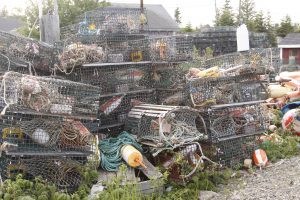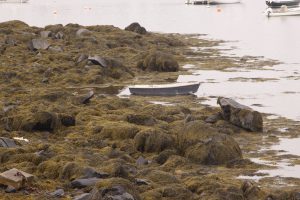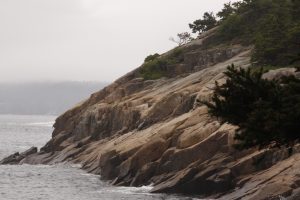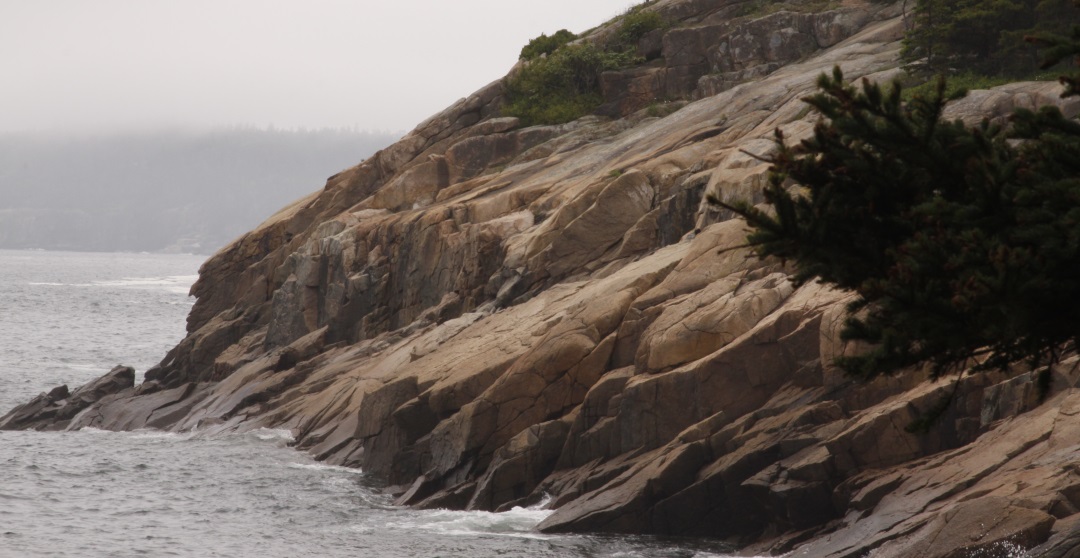Water Closet for February 9, 2018
[pullquote]”From the 17th century on the land eventually called Maine had more than its share of ambitious exploiters and land grabbers, the most ruthless operating out of England and its New World center in Boston”[/pullquote]
Middleton Stream Teamer Red Caulfield has done it again. He found another important book he shares with us. Those he finds in used book stores are often by little known Yankee authors. The latest, published just 13 years ago, is Colin Woodard’s The Lobster Coast: Rebels, Rusticators, and the Struggle for a Forgotten Frontier. Red, a longtime lover of Maine, and the old Closeteer are friends of a couple who moved their business, Boston Jojoba, from Middleton to Waldoboro, Maine, in 2005. We worried about how the outsiders, a main theme of Woodard’s from the 1500s to the present, would be received by inhabitants proud of their legendary independent ways. “They can’t get here from there.” Owners Robert and Sally Butler adapted surprisingly quickly. Bob soon became a crackerjack selectman who among other things saved Waldoboro lots of money by reviewing its insurance policies. Sally, a good Middleton conservation commissioner here from 1996 to 2005, joined her area’s Medomak River Land Trust and rose to leadership within. They hired locals to help with their successful business. After reading Woodard’s fine history of Maine we understand why they were so readily accepted. Bob and Sally are doers who just didn’t go to Maine to enjoy summers along the lovely coast. Bob from Minnesota and Sally from England became Mainers as quickly as they had become valued Middletonites. Woodard’s history covers over five centuries of people coming and the changes they wrought. What is happening now is summed up in this sentence by a boatbuilder who like many lobstermen can no longer afford to live near their work. “If you make it a residential community then you’ve got a dead town; you’ve got no future, and the young people have to move away.” This is what is happening all along the coast of Maine. Those with lots of money, many from elsewhere, buy the shore and force the smelly, noisy businesses out. In the cold months many of the coastal mansions are empty. Many lobstermen drive a half-hour or so from the interior where land is cheaper to reach their boats.

Over three million of these traps are set each year along the coast of Maine. Over 6000 men and women own and tend them every two or three days. The fish are mostly gone, lobsters not fish are now Maine’s viable “fishery.” – Pam Hartman photo
The reason for mentioning the Butlers with Woodard’s important book is because the lifelong Maine author weaves his chapters around relationships, often contentious, with outsiders. From the 17th century on the land eventually called Maine had more than its share of ambitious exploiters and land grabbers, the most ruthless operating out of England and its New World center in Boston. Many of those early villains were absentee landlords with questionable grants from Kings and Lords, Native Americans and poor settlers be damned. Samuel Waldoboro one of the worst has a county and town named after him. Another seeking fame and fortune was General Henry Knox, Revolutionary hero and one of Washington’s most trusted advisors. Young Knox had aristocratic visions of grandeur as a feudal landlord on large holdings in Maine. Woodard comes down hard on those who took advantage in the often-chaotic affairs of Maine where Indian strife and enmity between the French and English waxed and waned to the detriment of the poor struggling with short growing seasons and thin soils.

The rocky intertidal coast of Maine at low tide can be seen draped in mats of seaweed. When the tide rises these attached algae float up and absorb light for photosynthesis. CO2 is taken in, O2 in given off in the process of food making. These rich habitats are nurseries for the sea. – Pam Harman photo
The old Closeteer who has long been interested in the coasts around the Gulf of Maine found this the best account he has read about Maine’s fisheries, history and coastal economy. Economics has always been his weak subject. Woodard using real folks and examples makes the subject much clearer. He intertwines sociology, marine science and economics from his extensive researches including working visits and interviews with fishermen, developers, historians and marine scientists. His sources have names and come alive as he hauls lobster traps and scuba dives with some. The reader feels he understands something of the beautiful state he has visited dozens of times. This history is far more than about Maine’s territory, it is about the Gulf of Maine on one of the richest continental shelves in the world where the cold Labrador and warm Gulf Stream currents and nutrients from a hundred rivers embrace over shallow banks. These riches have long been surrounded by very poor people. Don’t be fooled by the yachty tourist harbors along the coast. A couple decades after WWII the world’s factory ship fleets visited the gulf and its banks where they decimated the fisheries which were already in decline. The 200-mile economic zone limiting fishing declared by Iceland in the early 1970s was soon followed by the United States and Canada. It was too late. The last two centuries decline in fish species is complicated and little understood. Woodard does well trying to explain what happened. We can’t wholly blame the world’s fishing fleets. They were visiting a place long mismanaged not so much by the locals as by our political leaders and the monied powers and their bottom-harrowing draggers so much in the news this last century. Woodard spares no one; he even takes on much respected Massachusetts Congressman Gerry Studds and venerable Maine Senators George Mitchell and William Cohen for backing off in their protection of the fish populations. They bowed to political pressures with not enough attention to science.

Millions of lobster traps are sprinkled in the cold water along 3500 miles of Maine’s tidal coastline. These rich habitats for lobster, crabs, and once countless large fish are nourished by waters off the Gulf Stream, the Labrador Current, and fresh water from many rivers. – Pamela Hartman photo
The Lobster Coast is a misleading title for this 318-page history with an additional 54 pages of footnotes and index. Catching lobsters, not fish, is the one profitable surviving maritime industry. Woodard describes well the latest research on the prey of thousands of lobster folks along thousands of miles of coast and far out on the continental shelf. Researchers using scuba gear, underwater cameras, and satellite data are finally learning about the lobster and its habitat. The Lobster Coast is about much more than lobsters; it includes the post glacial formation of the Gulf of Maine and how the actions of England, France, Indian nations, and Massachusetts affected the whole region. Had Woodard with all his knowledge been given his freedom this book might have been thousands of pages long. He and his editors did a masterful job giving us such an informative and very readable book in such a small lively package in which real Mainers, many still alive, play an active role.
The Closeteer goes further in his raves for The Lobster Coast declaring that if he was the benevolent dictator of the Maritimes and New England around the gulf and its offshore banks he’d require all his officials to read it and then pass a test. It would be the basis of required courses in all colleges in Massachusetts, New Hampshire, Maine, New Brunswick, and Nova Scotia. He wouldn’t last long of course; the independent Maine fishermen, now largely just lobstermen and women, the other fisheries gone, would keel haul him and use his remains for bait. He’d settle for this after all those so required had read.
_________________________________________________________
WATER RESOURCE AND CONSERVATION INFORMATION
FOR MIDDLETON, BOXFORD AND TOPSFIELD
| Precipitation Data* for Month of: | Oct | Nov | Dec | Jan | |
| 30 Year Normal (1981 – 2010) Inches | 4.44 | 4.55 | 4.12 | 3.40 | |
| 2017 Central Watershed Actual | 4.03 | 1.54 | 2.97 | 4.9 | |
Ipswich R. Flow Rate (S. Middleton USGS Gage) in Cubic Feet/ Second (CFS):
For Jan 26, 2018 Normal . . . 59 CFS Current Rate . . .75.6 CFS
—————————————————————–
*Danvers Water Filtration Plant, Lake Street, Middleton is the source for actual precipitation data thru Dec..
** Middleton Stream Team is the source of actual precipitation data for Jan.
Normals data is from the National Climatic Data Center.
THE WATER CLOSET is provided by the Middleton Stream Team: www.middletonstreamteam.org or <MSTMiddletonMA@gmail.com>


mbz9 hello my website is mbz9
slot 1b hello my website is slot 1b
cho tot hello my website is cho tot
carving hello my website is carving
cicip hello my website is cicip
erek2 16 hello my website is erek2 16
Cash 5 hello my website is Cash 5
salahku hello my website is salahku
js加密 hello my website is js加密